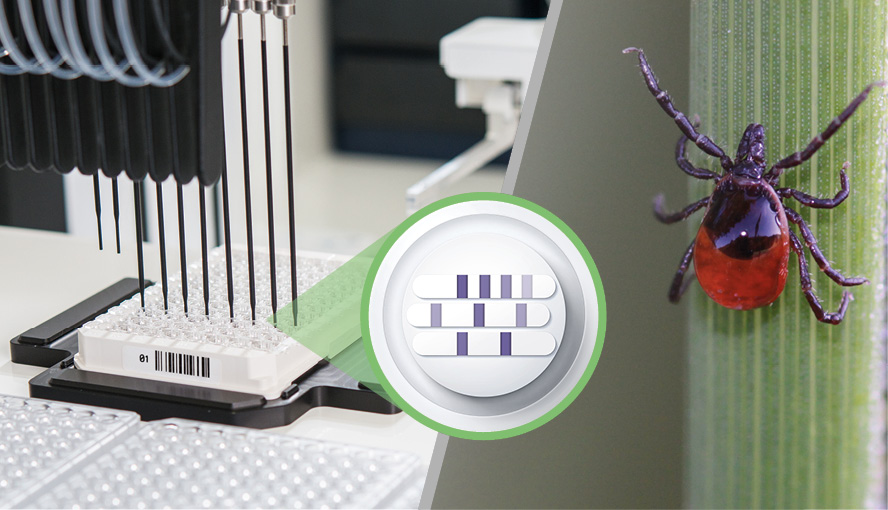With the rising temperatures in spring and summer, ticks also become more active again. They are practically everywhere where there are plants. They are waiting in exposed places such as grass for a desirable host to pass by and latch onto it when they make contact. In humans, they usually crawl into protected body regions such as armpits, elbows or genital areas in their often hours-long search for a suitable place to feed. However, if you check your body carefully after a stroll in the woods or a picnic in the countryside, you can usually find and remove them before they bite.
Lyme disease
In Germany, the common wood tick (Ixodes ricinus) is the most frequent tick species and the host for various viruses, bacteria and parasites, which are transmitted to humans during the blood meal and can cause a number of infections. The most common of them is Lyme disease, which is caused by bacteria of the Borrelia (B.) genera. The most relevant species leading to infections in humans are B. afzelii, B. burgdorferi and B. garinii. Unlike the pathogens of tick-bite encephalitis (TBE), for instance, Borrelia are found in ticks throughout Germany. Depending on the region, up to 30 percent of ticks are infected with Borrelia. Antibody analyses in Germany and Switzerland showed that 2.6 to 5.6 percent of persons developed a Borrelia infection after a tick bite. Generally, only a small number of infected individuals show specific symptoms.
The clinical picture of Lyme disease varies greatly. It can include dermatological, neurological and internal signs and symptoms. An early sign of Borrelia infection is erythema migrans, a skin rash that spreads in a circle around the site of the bite. The rash occurs a few days to several weeks after the infection and is often accompanied by other manifestations. Early diagnosis and treatment with antibiotics is important in this case to prevent long-term consequences such as neuroborreliosis or arthritis.
Complete test portfolio for borreliosis diagnostics
The diagnosis of Lyme disease is based on the patient history, clinical findings and the detection of antibodies against Borrelia antigens. The broad range of EUROIMMUN test systems for antibody detection enables qualified two-tier borreliosis diagnostics in accordance with international recommendations (DGHM; RKI, Berlin, Germany; CDC, Atlanta, USA).
In the first step of diagnostics, the patient sera are analysed with a sensitive screening test such as an ELISA or chemiluminescence immunoassay (ChLIA). In the second step, positive and borderline results are investigated using an immunoblot as confirmatory test. This enables characterisation of the antibodies and differentiation between specific and unspecific reactions. EUROIMMUN offers a comprehensive range of tests based on these detection methods to suit all laboratory requirements. The ELISAs use native antigens from whole extracts of different Borrelia species. They are particularly sensitive, as they are based on a broad antigen spectrum that comprises all diagnostically relevant proteins, including the important early-phase antigen OspC and the main antigen VlsE (in IgG detection). In comparison, ELISA and ChLIA, which are based on a mixture of selected, highly specific recombinant antigens, show less cross-reactivity. In particular, the specially developed dimeric form of OspC has a higher specificity compared to conventional monomeric OspC. Yet the designer antigen remains just as sensitive as the native antigen. Our ELISA and ChLIA range is complemented by an indirect immunofluorescent test (IIFT) that uses bacterial smears in combination with OspC and VlsE antigen dots.
The EUROIMMUN blots for confirmation of the test results are also based on exclusive compositions of recombinant and partly native antigens: early-phase markers OspC and VlsE of different Borrelia species, late-phase markers and immunoreactive designer antigens as well as whole extracts of the bacteria. The immunoblot formats include the well-established EUROLINE and EUROLINE-WB test strips as well as the soon-to-be-available EUROMicroblots – miniaturised blot strips in a 96-well microplate format for high-throughput analyses.
In suspected cases of neuroborreliosis, antibody synthesis in the cerebrospinal liquid (CSF) can be investigated by means of EUROIMMUN ELISAs or immunoblots that are also validated for use with CSF samples. In addition, measurement of the messenger substance CXCL13 in the CFS using EUROIMMUN ELISAs supports the early detection of acute neuroborreliosis. CXCL13 is also a marker for therapy monitoring, as its concentration in the CSF decreases with successful antibiotic treatment.
Automation solutions
To increase the efficiency and standardisation of borreliosis diagnostics, EUROIMMUN offers flexible automation solutions up to fully automated processing for all EUROIMMUN test systems for the detection of antibodies against Borrelia antigens. Our diverse range of ELISA, ChLIA, IIFT and immunoblot instruments meets different diagnostic strategies and throughput requirements. The soon-to-be-available EUROMicroblot microplates can be conveniently processed in the same run as ELISA plates on the automated systems EUROLabWorkstation ELISA, EUROIMMUN Analyzer I or I-2P and provide full traceability due to barcode recognition. Subsequently, images of the incubated EUROMicroblots are taken with the soon-to-be-available Microwell Imager. The results are evaluated with the proven EUROLineScan software.
Learn more about our soon-to-be-available EUROMicroblots in this video
